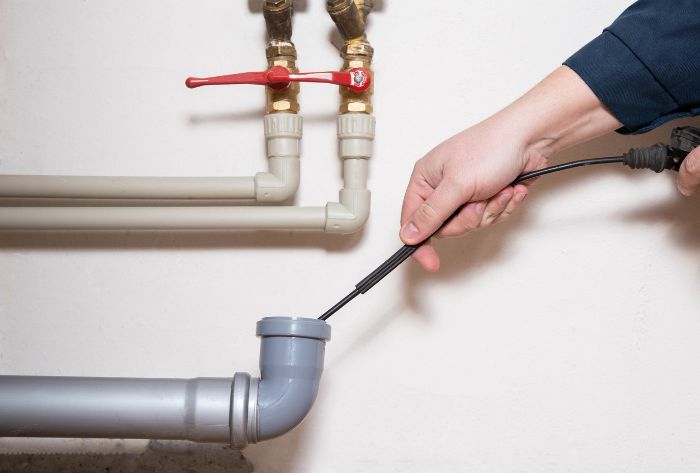
Drain Cabling in Winter: Why It’s More Important Than Ever
TLDR: Understanding the seasonal impact on drain systems is crucial for effective winter maintenance. Drain cabling in winter helps prevent snow and ice build-up, reducing stress and potential damage. Common winter drain issues include frozen pipes, blockages, and build-up of grease and debris, which can be addressed with proper insulation, regular cleaning, and professional drainage services. Key tools and techniques for winter drain cabling involve careful planning, equipment like power probes and excavators, and using plastic-coated steel cable. Regular inspections are essential for detecting and fixing issues before freezing temperatures set in.
Understanding the seasonal impact on drain systems is essential for effective management of winter weather. This article aims to discuss the importance of drain cabling in the winter months, common winter drain issues and their solutions, as well as providing key tools and techniques which can be used for winter drain cabling.
Understanding the Seasonal Impact on Drain Systems
Understanding the Seasonal Impact on Drain Systems is essential for proper outdoor drainage maintenance and upkeep. In the winter months, when colder temperatures make the ground less absorbent, the standing water can freeze and cause disruptions and cracks in your drain system. Heavy snowfall in winter can prevent the draining water from escaping, leading to backups and, in extreme cases, flooding.
On the other hand, in the summer months, the heat from the sun makes soil more saturated and causes groundwater to rise. This can cause water to pool in drainage systems instead of escaping as it should be and can lead to issues such as clogging from sediment. Similarly, in places with heavy rainfall over summer months, the additional water can cause blockages due to collecting debris, leaves, or garbage, and can magnify any existing issues.
In addition, from season to season, pipes may undergo natural changes in their environment that can affect their integrity. For instance, in areas where the ground freezes in winter, ground swelling may cause pipes to become misaligned or even crushed, making them less effective at draining.
As a result, it is important that sufficient drainage maintenance is conducted across all seasons to prevent potential issues and ensure proper drainage is maintained in outdoor drainage systems. This includes thorough cleaning of pipes and drainage systems to remove any debris, and should be done in early fall and late spring. Consequently, it is essential that pipes, drainage systems, and grates are checked regularly throughout the year, both before and after extreme weather, to ensure they are all functioning correctly.
Why Drain Cabling Matters in Winter Months
When it comes to effective and easy snow removal, drain cabling in winter months is essential. It helps to prevent the formation of large icy patches and further aids in ensuring snow doesn’t build up. Additionally, drain cabling helps to decrease the anxieties and stress that accompany the winter months.
Cabling is an effortless means of ensuring that all drainage systems are functioning, including sewer, downspouts, and even storm drains. This process can prevent any flooding or water damage due to melting snow or drainage blockages. When property-owners are required to periodically tend to the condition of their drains, it can serve as a reminder to them to check their systems for any blocks or any other defects.
On the other hand, drain cabling proves beneficial in preventing inconvenience for those living in a winter climate. This is because it helps to reduce the possibility of a snow or ice-related back-up on a property. Similarly, it aids in avoiding strong storms and their related damages from occurring.
However, drain cabling is not a ‘one-time fix’. For instance, the pools of liquid caused due to usingurable temperatures also can be eliminated through proper cabling. Additionally, due to the large influx of snow melting in springtime, cabling can also help keep drains flowing and functioning well. As a result, it helps to ensure that any additional accumulation of moist snow and/or water is controlled.
In contrast to costly replacements, drain cabling is a much less expensive way in which to protect a home from potential damage in the winter months. Consequently, it serves as a deterrent against the possible formation of water-based disasters such as flooding and back-ups.
Overall, as an effective and relatively low-cost way to protect a home in the winter, drain cabling is an necessary form of maintenance to ensure the safety of a property and its residents.
Common Winter Drain Issues and Their Solutions
Winter often brings with it colder temperatures and precipitation, which can affect drains in a variety of ways. Most commonly, the frozen temperatures of winter can can cause water in the pipes to freeze, leading to blockage or burst pipes. Additionally, a significant amount of precipitation can combine with debris and cause blockage, leading to drainage problems. Clogged drains can be filled with snow or ice, which will not only lead to drainage problems but can become potential health and safety hazards.
However, there are a variety of solutions to these common winter drain issues. One of the most effective solutions is to simply keep the drains clear before winter by utilizing yearly cleaning to ensure that debris does not enter the drains and cause blockage. In addition, it is important to add layers of insulation and heat to the exposed pipes near areas apt to experience extreme cold. If issues have already occurred, professional draining services can be used to efficiently clear and repair affected piping, including for burst pipes or areas of standing water.
Consequently, a variety of measures can be taken to avert winter drain issues before they arise, as well as address any issues that do arise in timely manner. From insulation to drain cleaning, there are multiple solutions available to ensure proper drain functioning during cold winter temperatures.
Key Tools and Techniques for Winter Drain Cabling
One of the most important steps in winter drain cabling is the planning that goes into the project. Planning ahead is essential when tackling winter drain cabling because the cold temperatures can make it difficult for the cable to penetrate the frozen ground and make it easier for the instruments to become damaged in the process. However, with the right tools and techniques, the job can be done efficiently and effectively.
A good first step is to use an electric power probe to identify any obstacles such as rocks or roots that could impede the tubing as it is inserted. This can be done in three main ways: by pushing the probe into the ground with a hammer, by dragging it behind a vehicle, or by driving it down with an auger or vibrator. In order to ensure that the cable is secure once it is in the ground, it is important to make sure the hole being excavated is of adequate size. For this purpose, an excavator or similar tool can be used.
In addition to equipment, the type of cable being used can impact the success of a winter drain cabling project. Plastic-coated steel cable is generally the most commonly used in winter drain cabling because it is more resilient and stronger than alternatives such as synthetic fibers. Similarly, the accessories and supporting brackets used to attach the cable should also be checked to make sure they can withstand the cold temperatures.
Finally, the installation of winter drain cabling calls for regular inspections to identify any issues. This is especially important because it is not possible to repair a broken cable line in the ground during the winter due to the frost line. Therefore, if a problem is detected early on, the line should be removed and repaired before the freezing temperatures set in.
Overall, winter drain cabling can be complicated and time-consuming. However, with the right preparation, the job can be done safely and efficiently. By properly planning the project, choosing the right type of cable, and regularly inspecting the line, the job can be completed successfully.
Final Thoughts
In conclusion, understanding the seasonal impact on drain systems as well as the importance of drain cabling in winter months, is valuable knowledge for any property owner or operator. Common issues encountered in winter months often involve frozen external pipes, blockages from debris, or a build-up of grease, oil and fat. Fortunately, there are a few techniques and tools for drain cabling which can help prevent these issues from occurring and even alleviate existing ones. It is important to remember that drain cabling is not a long-term option. Therefore, taking preventative measures such as insulating external pipes, decreasing inflow of oil, grease and fat into the drains and scheduling regular inspections or using CCTV surveying are essential to ensure that any future issues are pointed out and tackled before they can worsen.
Frequently Asked Questions
What is drain cabling
Drain cabling, sometimes called drain cleaning or drain snaking, is a process of clearing blocked drains using a long, flexible cable. The cable is connected to a drain auger, a special tool designed to clear blockages. The auger is inserted into the drain and manually pushed through to remove the blockage. It can also be operated by a motor and operated remotely if necessary. Drain cabling is an effective way to clear clogged and blocked drains quickly and with minimal disruption.
and why is it important in winter?
Winter often brings colder temperatures and harsher weather conditions, which can be dangerous for people. It is important to take the necessary precautions during this season, such as wearing warm clothes, using deicing agents on outdoor surfaces, being extremely cautious when driving in wintery conditions, and making sure to have an emergency kit in your vehicle. Taking these steps can help keep you safe and prevent any hazards from occurring.
How does cold weather affect drain systems?
Cold weather can have a major effect on drain systems. As the temperature drops, water can freeze in the pipes, causing blockages and preventing efficient draining. Additionally, the frozen water in the pipes can expand and burst the pipes, leading to major flooding. It is important to take necessary steps such as insulating pipes, running warm water through the system, and adding de-icing agents to the system to decrease the chances of freezing and avoid costly damages.
What are the common winter drain issues homeowners face?
Common winter drain issues homeowners face include frozen pipes, broken pipes and increased levels of debris in pipes due to snow and ice melting. Frozen pipes can cause a backflow of sewage if the pipes burst. This can lead to major plumbing problems and the need for costly repairs. Broken pipes can cause flooding and water damage if they’re not fixed quickly. Debris in pipes caused by snow and ice melting can clog drains and eventually cause overflows in the home.
Can I perform drain cabling myself
No, it is generally not advisable to attempt to perform drain cabling yourself. This is a job that should be left to a professional. Drain cabling involves using specialized equipment such as augers and cables to clear out clogged drains and pipes and performing the job incorrectly could cause further damage or even harm.
or should I hire a professional?
The answer to this question depends on your specific needs and resources. If you have the budget and need a professional-level job, then hiring a professional may be the right choice. However, if you have the time and resources to do the job yourself, then you might be able to save money by doing so. The best way to decide is to weigh out the pros and cons of each option to determine which one makes the most sense for you.
Have any questions?
Give us a call 24/7!
(520) 655-6400
Or
